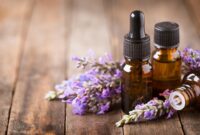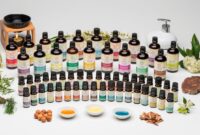Sell essential oils – Embark on a fragrant journey into the world of essential oils, where nature’s therapeutic wonders unveil their remarkable potential. From the serene aromas of lavender to the invigorating scents of citrus, essential oils captivate the senses, offering a myriad of benefits that enhance well-being and transform daily life.
This comprehensive guide delves into the intricacies of selling essential oils, empowering you with the knowledge and strategies to establish a successful and fulfilling business. Discover the latest market trends, explore effective sales techniques, and learn how to create a brand that resonates with your target audience.
Prepare to immerse yourself in the aromatic world of essential oils and unlock the path to profitability and holistic wellness.
Essential Oils Market Overview

The global essential oils market size was valued at USD 8.9 billion in 2022 and is projected to reach USD 16.8 billion by 2030, exhibiting a CAGR of 8.1% during the forecast period.
The market growth is primarily driven by the rising demand for natural and organic personal care products, increasing use of essential oils in aromatherapy, and growing awareness about their therapeutic benefits.
Key Market Segments
The market is segmented based on product type, application, and distribution channel.
- Product Type:The market is dominated by citrus oils, followed by mint oils, spice oils, and floral oils.
- Application:Essential oils are primarily used in personal care and cosmetics, followed by aromatherapy, pharmaceuticals, and food and beverages.
- Distribution Channel:The market is dominated by online channels, followed by retail stores and specialty stores.
Impact of COVID-19
The COVID-19 pandemic had a significant impact on the essential oils market. The demand for essential oils surged during the initial stages of the pandemic due to their perceived antiviral and antibacterial properties.
However, the supply chain disruptions and economic slowdown led to a decline in demand in the later stages of the pandemic.
Benefits of Essential Oils
Essential oils, concentrated plant extracts, possess remarkable therapeutic properties that have been harnessed for centuries. Their versatility extends from aromatherapy and skincare to household cleaning, offering a holistic approach to well-being.
Scientific research has substantiated the therapeutic efficacy of essential oils. Their volatile compounds interact with the body’s receptors, triggering physiological and psychological responses.
Aromatherapy
In aromatherapy, essential oils are diffused into the air or applied topically to promote relaxation, reduce stress, and alleviate symptoms of respiratory conditions. For instance, lavender oil has been shown to induce tranquility and improve sleep quality.
Skincare
Essential oils are renowned for their beneficial effects on the skin. Tea tree oil, with its antibacterial and anti-inflammatory properties, is effective in treating acne. Rosehip oil, rich in vitamins and antioxidants, promotes skin regeneration and reduces wrinkles.
Household Cleaning
Essential oils are natural disinfectants that can effectively clean and deodorize surfaces. Eucalyptus oil, with its antimicrobial properties, is ideal for disinfecting countertops and floors. Lemon oil, known for its degreasing ability, can remove grease from surfaces.
Target Audience for Essential Oils
Essential oils appeal to a diverse range of individuals seeking natural solutions for their health and well-being. Understanding the demographics and psychographics of potential customers is crucial for targeted marketing and effective communication.
Demographics
- Age:Primarily adults aged 25-65, with a higher concentration in the 35-55 age group.
- Gender:Women are more likely to use essential oils than men, comprising approximately 80% of the market.
- Income:Essential oils tend to be more popular among individuals with higher disposable incomes.
- Education:Those with higher levels of education are more likely to use essential oils due to a greater awareness of natural health practices.
Psychographics
- Health-Conscious:Individuals who prioritize natural and holistic approaches to health and wellness.
- Eco-Friendly:Those concerned about environmental sustainability and the use of natural products.
- Stress-Relieved:People seeking relaxation, stress reduction, and improved sleep.
- DIY Enthusiasts:Individuals interested in creating their own natural products and remedies.
Needs and Motivations
Potential customers use essential oils for various purposes, including:
- Health and Wellness:To promote overall well-being, alleviate stress, and support physical health.
- Beauty and Skincare:To improve skin health, reduce blemishes, and enhance hair growth.
- Aromatherapy:To create a calming or invigorating atmosphere, promote relaxation, and improve sleep.
- Natural Cleaning:To replace harsh chemicals with natural disinfectants and cleaning agents.
Best Channels to Reach Them
Effective channels for reaching the target audience for essential oils include:
- Online Marketplaces:E-commerce platforms such as Amazon and Etsy offer a wide selection of essential oils and related products.
- Health Food Stores:Specialty stores that cater to health-conscious consumers, offering a curated selection of essential oils.
- Social Media:Platforms like Instagram and Pinterest allow brands to connect with potential customers through visually appealing content and targeted advertising.
- Wellness Blogs and Websites:Content-rich platforms that provide information on essential oils, their uses, and benefits.
Essential Oils Sales Strategies: Sell Essential Oils
Developing a comprehensive sales strategy is crucial for the success of any essential oil business. This strategy should Artikel the target market, pricing structure, promotional tactics, sales materials, and marketing campaigns.
To design an effective sales strategy, it is essential to understand the target audience, their needs, and preferences. Based on this understanding, businesses can tailor their sales approach to resonate with the target market.
Pricing Structure
Establishing a pricing structure that aligns with the target market and industry standards is essential. Factors to consider include production costs, market competition, and perceived value. Businesses should also consider offering discounts, bundles, and loyalty programs to attract and retain customers.
Promotional Tactics
Effective promotional tactics can increase brand awareness and drive sales. This includes leveraging social media platforms, running targeted advertising campaigns, and partnering with influencers or bloggers.
Sales Materials and Marketing Campaigns
Creating compelling sales materials and launching targeted marketing campaigns is crucial for communicating the benefits and value of essential oils. Sales materials should provide detailed product information, usage instructions, and testimonials. Marketing campaigns should focus on educating potential customers about the benefits of essential oils and showcasing the unique features of the brand’s products.
Essential Oils Distribution Channels
Selecting the appropriate distribution channels is crucial for reaching your target audience and achieving sales success. Let’s explore the various distribution options for essential oils and analyze their advantages and disadvantages.
Online Marketplaces
- Pros:Wide reach, convenience for customers, potential for higher sales volume.
- Cons:Competition, platform fees, limited control over product presentation.
Retail Stores
- Pros:Physical presence, opportunity for customers to experience products, brand building.
- Cons:Limited reach, higher overhead costs, reliance on retail partnerships.
Direct Sales, Sell essential oils
- Pros:Personalized customer interactions, strong brand loyalty, control over distribution.
- Cons:Time-consuming, requires a sales force, can be challenging to scale.
Choosing the Most Suitable Channel
The most suitable distribution channel depends on factors such as your target audience, product positioning, and business model. Consider the following:
- Target Audience:Online marketplaces may be more suitable for reaching a wider audience, while retail stores or direct sales can provide a more personalized experience for specific customer segments.
- Product Positioning:If your essential oils are premium or niche products, direct sales or retail stores can help establish a stronger brand image and control the customer experience.
- Business Model:Direct sales may be more suitable for businesses with a focus on building long-term customer relationships, while online marketplaces or retail stores can offer a faster route to market.
By carefully evaluating these factors, you can select the distribution channels that best align with your business objectives and effectively reach your target audience.
Essential Oils Product Development
The essential oil industry is constantly evolving, with new trends and innovations emerging all the time. In order to stay ahead of the curve, it is important to be aware of the latest trends in essential oil product development.
One of the most important trends in essential oil product development is the increasing popularity of natural and organic products. Consumers are becoming more and more interested in using products that are made with natural ingredients, and this trend is expected to continue in the years to come.
Opportunities for Innovation and Differentiation
There are many opportunities for innovation and differentiation in the essential oil product development space. Some of the most promising areas for innovation include:
- Developing new essential oil blends that are tailored to specific needs, such as relaxation, sleep, or pain relief.
- Creating new essential oil products that are easy to use and convenient to apply.
- Developing new essential oil products that are safe for use on children and pets.
Examples of Successful Essential Oil Products
There are many successful essential oil products on the market today. Some of the most popular products include:
- Lavender essential oil, which is known for its calming and relaxing effects.
- Peppermint essential oil, which is known for its invigorating and stimulating effects.
- Tea tree essential oil, which is known for its antibacterial and antifungal properties.
Essential Oils Branding and Packaging
Establishing a strong brand identity and developing eye-catching packaging are crucial for the success of your essential oils business. Your brand should resonate with your target audience, while the packaging should protect the product’s integrity and reflect the brand’s values.
Creating a Strong Brand Identity
- Define your brand’s values, mission, and target audience.
- Create a brand name and logo that are memorable and relevant.
- Develop a consistent brand voice and messaging across all marketing materials.
Designing Eye-Catching Packaging
- Use high-quality materials that protect the essential oils from light and oxidation.
- Incorporate design elements that reflect the brand’s identity and appeal to the target audience.
- Consider using eco-friendly packaging materials to align with consumer preferences for sustainability.
Meeting Industry Standards and Regulations
- Ensure that your packaging meets industry standards for labeling and safety.
- Comply with all applicable regulations regarding the handling and storage of essential oils.
- Obtain necessary certifications or licenses to demonstrate the credibility and legitimacy of your business.
Essential Oils Customer Service

Providing exceptional customer service is crucial for the success of any essential oil business. By developing a comprehensive strategy, businesses can ensure they are meeting the needs of their customers and building lasting relationships.
Excellent customer service should be provided through multiple channels, including phone, email, live chat, and social media. Businesses should also consider offering self-service options, such as a knowledge base or FAQ section on their website.
Building Strong Relationships with Customers
Building strong relationships with customers is essential for any business, but it is especially important in the essential oil industry. By getting to know their customers and understanding their needs, businesses can provide personalized recommendations and build trust.
- Personalize interactions by using customer names and remembering their preferences.
- Respond to inquiries promptly and professionally.
- Offer incentives for repeat purchases and referrals.
- Use social media to engage with customers and build a community.
Closing Notes

As you embark on this aromatic endeavor, remember that the true essence of essential oils lies in their ability to elevate the human experience. By harnessing their therapeutic powers and sharing their transformative qualities, you not only create a thriving business but also contribute to the well-being of your customers.
May your journey be filled with fragrant success and the unwavering belief in the transformative power of nature’s aromatic gifts.
Clarifying Questions
What are the key benefits of using essential oils?
Essential oils offer a wide range of therapeutic properties, including relaxation, stress relief, improved sleep, pain reduction, and enhanced cognitive function.
How can I incorporate essential oils into my daily routine?
You can diffuse essential oils in your home or office, apply them topically diluted in a carrier oil, or add them to your bathwater for a relaxing and rejuvenating experience.
What are the important factors to consider when choosing essential oils?
Purity, quality, and extraction method are crucial factors to ensure the effectiveness and safety of essential oils. Look for reputable brands that provide third-party testing and follow industry standards.


